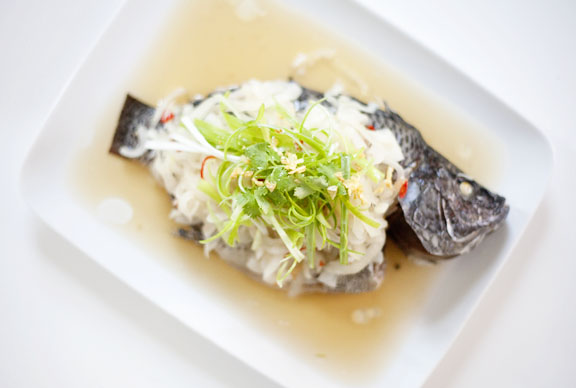I have to start this post with a little disclaimer: I have no idea how Burmese this dish is. But I do have an aunt who comes from Burma, and my grandma learned this dish from her. In our family, we always just called it “Burmese fish.” I loved it so much growing up that it’d be the first thing my grandma would feed me whenever I visited her.
My favorite part of this dish is the cured onions. This may be why it may seem a little proportionally off when you follow the recipe (I like having it with every bite!). The curing takes the bite out of the onion and draws out some of its natural sweetness. To this we add fresh cilantro, scallions, and some nuoc cham sauce. We usually eat this at room temperature, which makes it a nice, fresh dish for summer.
Burmese Fish
Serves 4 as part of a larger meal
It’s important to use fresh fish, especially when cooking it delicately and pairing it with simple ingredients. You can steam this in a wok or deep skillet or, alternatively, poach it, which is my mom’s current favorite method. She claims poaching helps release any fishy smells as well as infuse the fish with flavor if you choose to add aromatics like onion, scallions, or ginger. (For a quicker method, my mom used to microwave the fish. It’s less moist, but it’s also less work.)
1 2-lb fresh tilapia, scaled, gutted, and cleaned
1/2 tsp kosher salt
1/4 tsp black pepper
1/tsp cornstarch
1 medium onion, sliced thinly
2 tsp salt
1-2 Thai bird chilies, sliced (remove seeds and ribs if you prefer it less spicy)
1/4 cup nuoc cham dipping sauce, or more to taste
2 cloves garlic, minced
2 Tbsp vegetable or canola oil
1 stalk scallion, cut into 2-inch pieces and thinly sliced lengthwise
a handful cilantro, torn
1. Marinate the fish for an hour or longer in 1/2 tsp salt, 1/4 tsp black pepper, and 1/2 tsp cornstarch.
2. Cure the thinly sliced onion by mixing in 2 tsp of kosher salt. Let it sit for at least 15 minutes.
3. Fill a deep skillet, pan, or wok with water — to a depth of 2 inches if steaming, or more (enough to cover the fish) if poaching. If desired, add aromatics like slices of onion, scallions, or ginger to the poaching liquid. Let the water come to a boil, and then add the fish (use a rack and plate if steaming or immerse the fish completely in the water if poaching). Turn the heat down to low, cover, and steam or poach the fish for about 5 minutes. To test for doneness, insert a chopstick into the fish. If it goes all the way through easily, the fish is done. If not, let the fish cook for a couple more minutes. When done, lift the fish carefully out, making sure to let all the liquid drain out if poaching. Set on a plate to cool.
4. When the onion has finished curing, rinse it several times in cold water to get rid of the salt. Squeeze all the moisture out of the onion. Set the onion in a bowl and add the sliced chilies and the nuoc cham dipping sauce.
5. Heat oil in a small pan over medium-high heat. Add minced garlic. Once the garlic turns golden, turn off the stove and take the pan off the heat. Drizzle the fried garlic and fried garlic oil over the fish.
6. Top the fish with the cured onion, chilies, and nuoc cham. Garnish with thinly sliced scallion and cilantro.











Connect with us